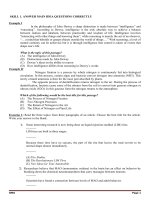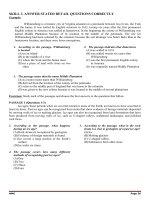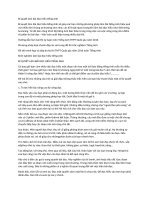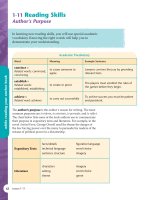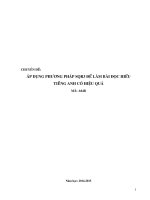Bài đọc hiểu tiếng anh
Bạn đang xem bản rút gọn của tài liệu. Xem và tải ngay bản đầy đủ của tài liệu tại đây (111.96 KB, 13 trang )
1. Hãy đọc đoạn văn sau và chọn câu trả lời tốt nhất trong số A, B, C và D.
The grasshopper is an insect found in all but the most frigid parts of the world. There
are two main types of grasshoppers: long-horned grasshoppers and short-horned
grasshoppers. The insects are distinguished by the length of their antennae, or feelers,
which can be called horns as well. Short-horned grasshoppers are also known as locusts.
Most grasshoppers start laying eggs in the late summer and early fall. The eggs hatch
the following spring. Unlike most insects, newborn grasshoppers resemble adults, except
for the absence of wings. In the second month of life, a young grasshopper sheds its shell
and grows a new one several times. This process, called molting, is the transition from
youth to adulthood.
Grasshoppers spend their time in fields and meadows eating the leaves of plants and
trees. Some varieties are particular about what they eat, but most will consume anything
they can find. At times they may destroy whole crops of grain, especially as swarms of
locusts. In the western United States, grasshoppers destroy several million dollars worth
of crops every year, despite efforts by farmers to control them with chemicals.
1. What is the main subject of this passage?
A. Insects of the world
B. Characteristics of grasshoppers
C. Cold-weather insects
D. The horns of the grasshoppers
2. According to the passage, grasshoppers do not survive well _______.
A. unless the temperature is quite frigid
B. if the two types share the same habitat
C. without the use of antennae
D. in extremely cold areas
3. According to the passage, how can we distinguish grasshoppers?
A. By the length of their feelers
B. By the number of horns
C. By the shape of their wings
D. By the size of their bodies
4. It can be inferred from the passage that grasshopper eggs _______
A. are uniform in size
B. are laid in early spring
C. require several months to hatch
D. have very soft shells
5. According to the passage, which of the following most commonly destroy crops?
A. Misuses of chemicals
B. Short-horned grasshoppers
C. Swarms of long-horned grasshoppers
D. Field and meadow insects.
2. Hãy đọc đoạn văn sau và chọn câu trả lời tốt nhất trong số A, B, C và D.
Regulations for the road user at railway level crossing
1. Approach a level crossing at a moderate speed and cross it with care. Do not cross too
slowly. Never drive over it too close to another vehicle. Never drive on to one unless you
can see the road is clear on the other side. Never stop on or immediately beyond any level
crossing.
2. Many level crossings have gates operated automatically or by an attendant. Some also
have orange lights followed by flashing red “Stop” lights. Do not pass the lights once
they show. If there are no lights at all, stop when the gates begin to close.
3. There are some unattended level crossings with gates which road users have to open
themselves, “Stop” signs, and small red and green lights. Do not cross when the red light
is showing, as a train is coming. There is a special railway telephone, and if you are
driving a very large or slow-moving vehicle, or are on foot with animals, you must first
telephone the nearest station to make sure it is safe for you to cross. Open both gates
before you cross and close them after you. When you have crossed, telephone the station
to let them know you are over.
4. Some other unattended level crossings have gates but have no red lights. At such
crossings, stop, look both ways, listen and make sure there is no train coming. If there is a
special railway telephone, first telephone to make sure it is safe for you to cross. Before
you cross with a vehicle or with animals, open the gates on both sides wide, and then
check once again that no train is coming. Drive your vehicle or animals right across and
well clear of the crossing and then close both gates.
1. All the level crossings described in the passage have _______.
A. flashing lights
B. attendants
C. telephones
D. gates
2. According to the instructions, you should cross all level crossings _______
A. without hesitating
B. in a vehicle
C. as cautiously as possible
D. as far as possible from the car in front
3. You should never drive on to any level crossing if _______.
A. another vehicle is approaching
B. the exit isn’t clear
C. the attendant has not operated the lights
D. a green light is flashing
4. At a crossing with gates you open yourself you are told to telephone the station if
_______.
A. a red light is showing
B. your car breaks down close to it
C. you are driving a very large vehicle
D. you have not closed the gates
5. Imagine you are going to drive across an unattended level crossing which has no
lights at all. What is the final thing you must do before actually crossing?
A. Open the near gate wide
B. Look to see if a train is coming
C. Telephone the nearest station
D. Listen for any animals approaching
3. Hãy đọc đoạn văn sau và chọn câu trả lời tốt nhất trong số A, B, C và D.
PURE SCIENCE AND APPLIED SCIENCE
Many of the latest scientific accomplishments fall in the realm of “pure” science. This
is research for the sack of increasing man’s knowledge without concern about how the
knowledge is going to be used. In contrast with pure science is “applied” science. The
production of synthetic diamonds is an example of applied science. In applied science the
facts and principles of pure science are used in the solution of a problem which was or
will have immediate economic and social importance.
Often in the past, applied science has gone far ahead of pure science. Its practical
applications have been used for man’s good even before the basic facts and principles
were understood. For example, the telegraph, telephone and electric motor, which could
not work without electrons, were invented before man discovered the electron. People
were vaccinated long before viruses were investigated. Chemicals like sulfuric acid and
soda were manufactured long before man began to understand the nature of the atom.
Today, however, if applied science is to grow it must depend more and more on,
increased knowledge of pure sciences.
1. The aim of pure science is _______
A. to promote the production of pure chemical
B. to solve practical problems of everyday life
C. to develop human knowledge of general principles of science
D. to apply scientific facts to the invention of electronic devices
2. Applied science has _______.
A. made our lives more comfortable with the understanding of basic scientific
theories
B. made our lives more enjoyable with the production of everything we need
C. given us the basic facts and principles of science
D. helped us research for the sake of increasing man’s knowledge
3. In the past, applied science went far ahead of pure science because _______
A. pure science has been discovered only in recent years
B. men understood the basic facts and principles of pure science before they
discovered and invented things
C. pure science had been considered less important than applied science.
D. many inventions and discoveries had been made before men knew the basic
scientific theories.
4. The fact that vaccination had been practised long before the investigation of viruses
means _______.
A. people devoted a lot of time to the study of pure science
B. applied science went far ahead of pure science
C pure science went far ahead of applied science
D. the study of pure science was delayed for a long time
5. If applied science is to develop more efficiently _______.
A. its practical applications must be used for man’s good.
B. people must devote more time to the study of the neutron and atomic energy
C. it must rely on the increasing knowledge of pure science
D. people must solve problems of immediate economic and social importance
4. Hãy đọc đoạn văn sau và chọn câu trả lời tốt nhất trong số A, B, C và D.
MONEY MATTERS FOR STUDENTS
GETTING A GRANT
Who pays? The local education authority (LEA) for the area in which the student is
living.
Who can get this money? Anyone who gets a place on a first degree course although a
student who has already attended a course of advanced further education may not.
Students must also have been resident in the UK for at least three years, which can
exclude some students from overseas.
SPECIAL CASES
If a student has worked before college: A student who is 26 or more before the course
starts and who has worked for at least three of the previous six years will get extra money
- £155 a year if 26, increasing to a maximum of £615 at 29 or more.
If a student is handicapped: LEAs will give up to £500 to help meet extra expensessuch as buying a tape recorder for a blind student, extra heating or special food.
Banking: Most of the big banks offer special services to students who open accounts (in
the hope that they will stay with the bank when they become rich executives). A student
won’t usually have to pay bank charges as long as the account stays in credit. Some
banks allow students to overdraw by £100 or so, and still don’t make charges (though
they do charge interest).
1. A student from Japan who has been staying in England for a year and intends to go to
college in a few months will _______.
A. get money if he is taking a first degree course
B. be unable to get money from any LEA
C. get money from an LEA when he has finished his course
D. have to open a bank account before he gets any money
2. A 31-year-old nurse wishes to qualify as a doctor at a university. She has worked
since she was 25. How much extra money will she get a year?
A. none
B.£155
C.£615
D.£715
3. A student who cannot walk has to buy a wheelchair costing £750 to go to classes.
How much of the cost will he have to pay himself?
A. £150
B £250
C. £ 500
D. £ 750
4. You are a new student. Why may a bank welcome you as a customer?
A. They know you receive money regularly.
B. They charge students extra.
C. They hope you will be rich in the future.
D. They need student accounts in term-time.
5. How much can students overdraw in some banks?
A. £100
B. £150
C. £200
D. £250
5. Hãy đọc đoạn văn sau và chọn câu trả lời tốt nhất trong số A, B, C và D.
During the teenage years, many young people can at times be difficult to talk to. They
often seem to dislike being questioned. They may seem unwilling to talk about their work
in school. This is a normal development becoming independent of teenagers trying to be
adult while they are still growing up. Young people are usually more willing to talk if
they believe that questions are asked out of real interest and not because people are trying
to check up on them.
Parents should do their best to talk to their sons and daughters about school work and
future plan but should not push them to talk if they don’t want to. Parents should also
watch for the danger signs: some young people in trying to be adult may experiment with
sex, drugs, alcohol or smoking Parents need to watch for any signs of unusual behaviour
which may be connected with these and get help if necessary.
1. This passage is taken from a _______.
A. handbook for parents
B. school timetable
C. teenage magazine
D. book for children
2. Why do adults sometimes find teenagers difficult to talk to?
A. Because most teenagers are quiet.
B. Because teenagers don’t want to talk to other people.
C. Because teenagers think adults are not honest.
D. Because most teenagers hate adults.
3. When can you expect young people to be more talkative than usual?
A. when people talk to them because they are really interested and not just checking
on them.
B. when adults give them a lot of money to spend.
C. when adults talk to them about something other than their work in school.
D. when adults talk to them about sex, alcohol and drugs.
4. Some teenagers experiment with drinking and smoking because _______.
A. cigarettes and alcohol are available everywhere
B. cigarettes and alcohol are cheap
C. women like smoking and drinking men
D. they regard them as a mark of adulthood
5. The word behaviour in the passage most nearly means _______.
A. feeling
B. manners
C. activities
D. reaction
6. Hãy đọc đoạn văn sau và chọn câu trả lời tốt nhất trong số A, B, C và D.
Are we being served? More than two thirds of those questioned in a recent survey
think service in Britain’s shops is not good enough and would pay more for better
treatment. This disappearance of personal service is not new. Our present dissatisfaction
began at least 40 years ago. When goods were scarce there was time to take pleasure in
the complicated art of selling, from greeting the customer to wrapping goods. The end of
the war, and the scarcity of goods which accompanied the wartime period, changed all
that. People wanted choice and quantity, to help themselves to what was on offer. Selfservice was born.
Throughout the Sixties and Seventies, productivity was the important word. In shops,
goods were piled up to ensure bigger sales. Supermarkets grew larger. The customer, by
contrast, shrank beneath the enormous piles of goods, pushed by the sound of the
background music towards the check-out.
At the end of the Seventies, however, owners of the larger stores thought again. The
customer was becoming more aware of what was on offer. Spending power had moved to
younger people with higher expectations from their hours of shopping. Design
consultants were called in and through the high street swept newly-designed stores and
goods. The customer benefited, no doubt about it, but look at any row of high street shops
from the north to the sound of Britain. They all look the same. They offer similar ranges
of goods on similarity colour-coordinated shop liftings.
The amusing thing is that market forces may be driving shops back to the first
principles of selling. In an attempt to be different from the competition, many of them
“are examining the quality of personal service. According to retail research analysts,
customer care programmes are an important competitive weapon. Already, a number of
big British companies have started new schemes. Edward Whitefield, who advises
companies on selling, says that about 50 of Britain’s top 500 companies are now trying to
improve their customer service. Many more, he believes, will follow.
1. A recent survey showed that about one third of those questioned _______
A. were satisfied with the shop service in Britain.
B. would pay higher prices for better service.
C. thought the service in Britain could be much better.
D. thought that personal service had disappeared.
2. It appears that, after the end of the war, customers _______.
A. wanted better service from shopkeepers
B. disliked the idea of everyone helping themselves in shops
C. discovered that some goods were becoming scarcer
D. lost interest in personal service
3. During the Sixties and Seventies, store owners were mainly concerned with _______
A. a better choice for the customer
B. the amount of goods sold
C. the type of assistants employed
D. the type of music played in their shops
4. By the end of the Seventies, however, store owners had decided to make shopping
_______.
A. easier for young people
B. available at all hours
C. a more pleasant experience
D. the same in all ‘stores
5. Many large companies reaslise that better customer service _______.
A. will increase competition
B. benefits smaller stores
C. attracts more business
D. improves the quality of goods
7. Hãy đọc đoạn văn sau và chọn câu trả lời tốt nhất trong số A, B, C và D.
There are two main types of concrete dams: arch dams and gravity dams. Arch dams
are tall, curved shells of concrete that can be as little as 3 metres thick. Their arched
shape gives them great strength. Large gravity dams are also made of concrete, but it is
their vast weight that prevents them from bursting.
The largest dams are embankment dams, which are made by piling up a huge barrier
of earth and rock. A core of clay or concrete in the middle keeps water from seeping
through the dam. The side is covered with stones to protect it from water. Rogunsky Dam
in the former Soviet Union is the world’s highest dam. It is 325 metres high. Hoover
Dam, one of the world’s highest concrete dams, measures 221 metres in height. It is an
arch dam that spans the Colorado River and supplies water for irrigation and electricity to
California, Arizona and Nevada.
1. The great strength referred to in paragraph 1 is a result of _______;
A. size
B. weight
C. shape
D. concrete
2. It can be inferred from the passage that gravity dams differ from arch dams in that
gravity dams are _______.
A. thicker than arch dams
B. not as sturdy as arch dams
C. not as attractive as arch dams
D. made of a different material than arch dams
3. According to the passage, the core of clay in the centre of an embankment dam serves
which purpose?
A. To support the structure
B. To hold the side together
C. To form the shape of the dam
D. To prevent water seepage
4. According to the passage, how tall is the Hoover Dam?
A. 325 metres
B. 185 kilometres
C. 221 metres
D. 3 metres
5. According to the passage, the water supplied from Hoover Dam is used for _______.
A. strength and support
B. irrigation and electricity
C. protection and irrigation
D. electricity and support
8. Hãy đọc đoạn văn sau và chọn câu trả lời tốt nhất trong số A, B, C và D.
The population of the world has increased more in modern times than in all other ages
of history combined. World population totalled about 500 million in 1650. It doubled in
the period from 1650-1850. Today the population is more than five billion. Estimates
based on research by the United Nations indicate that it will more than double in the
twenty-five years between 1915 and the year 2000, reaching seven billion by the turn of
the century.
No-one knows the limits of population that the earth can support.Thomas Malthus, an
English economist, developed a theory that became widely accepted in the nineteenth
century. He suggested that because world population tended to increase more rapidly than
the food supply, a continual strain was exerted upon available resources. Malthus cited
wars, famines, epidemics, and other disasters as the usual limitations of population
growth.
With recent advances in science and technology, including improved agricultural
methods and great strides in medicine, some of the limiting factors in population growth
have been lessened, with obvious results. International organizations have put forward
several recommendations to alleviate the problem of overpopulation, including an
increase in food production, general economic development in target areas, and a
decrease in birth rates. Most experts agree that it will be necessary to combine all three
recommendations in an effort to effect a lasting solution.
1. The title below that best expresses the ideas in this passage is _______.
A. Thomas Mathus’s Theory
B. The United Nations’ Estimate
C. Limiting Factors in Population Growth
D. A Brief History of Population and Overpopulation
2. World population doubled in the years between _______.
A. 500-1650
B. 1650-1850
C. 1650-today
D. 1850-2000
3. According to this passage, by the year 2000 the earth’s population should exceed the
present figure by how much?
A. 500 million
B. Five billion
C. Two billion
D. Seven billion
4. According to this passage, why has overpopulation been caused?
A. Improved technology
B. Disasters
C. Scarcity
D. Precaution
5. ‘What do most experts recommend in order to solve problems of overpopulation?
A. Famine and epidemic
B. Medical advanced and improved agricultural methods
C. Economic development and a decline in the birth rate
D. Conservation of available resources
9. Hãy đọc đoạn văn sau và chọn câu trả lời tốt nhất trong số A, B, C và D.
FIRE INSTRUCTIONS
THE PERSON DISCOVERING A FIRE WILL:
1. OPERATE THE NEAREST FIRE ALARM. (This will cause the Alarm Bells to
ring, and also send a signal to the telephone switchboard operator who will
immediately call the Fire Brigade).
2. ATTACK THE FIRE WITH AVAILABLE EQUIPMENT, IF IT IS SAFE TO
DO SO
FIRE ALARM BELLS
The Fire Alarm Bells will ring either in the area of A Block (Workshops and
Administration Offices) or in the area of B Block (Teaching) and C Block (Sports Hall).
Those in the area where the Alarm Bells are ringing should take action as indicated
below. Others should continue with their work.
ON HEARING YOUR FIRE ALARM:
1. Those in class: will go to the Assembly Area under instructions given by the teacher.
2. Those elsewhere: will go to the Assembly Area by the most sensible route, and stay
near the Head of their Department.
ASSEMBLY AREA
The Assembly Area is the playing field which is south of the Sports Hall. Here
names will be checked.
PROCEDURE
1. Move quietly.
2. DO NOT stop to collect your personal belongings
3. DO NOT attempt to pass others on your way to the Assembly Area.
4. DO NOT use the lift.
FIRE ALARMS
Fire Alarms are situated as follows:
1 Administration Block
At the Reception Desk; at east end of connecting corridor; outside the kitchen door,
back of the stage in the Main Hall
2 Teaching Block
At the bottom of both stairways and on each landing.
3 Workshops
Outside Machine Shop No 1; Engineering Machine Shop No 2
4. Sports Hall
Inside entrance lobby
1 The passage consists of advice on fire safety for _______.
A. people using a new kind of equipment
B. workers in an engineering factory
C. young children at school
D. students at college
2 When a person discovers a fire what is the first thing he should do?
A. Attempt to put it out himself
B. Telephone the switchboard operator
C. Start the alarm bells ringing
D. Contact the fire brigade
3. Everyone in the block where the fire bell has rung must gather for a check of names
_______
A. in another block
B. in the administration office
C. in one of the playing fields
D. in the sports hall’
4. Imagine you are a typist in the administration office, when a fire breaks out in the
sports hall. What should you do, according to the fire instructions?
A. Look for the fire-fighting equipment
B. Go quickly to the assembly areas
C. Go to the reception desk
D. Carry on with the work you are doing
5. Imagine you are a teacher. What is your first duty in case of fire?
A. To check the names of your students from a list.
B. To lead your students out of the building.
C. To get detailed instructions from your Head of Department.
D.
To patrol the stairways and landings.



